(新)胡壮麟语言学教程笔记第8-9章
Chapter 8 Pragmatics 语用学 语言学教程 胡壮麟.ppt
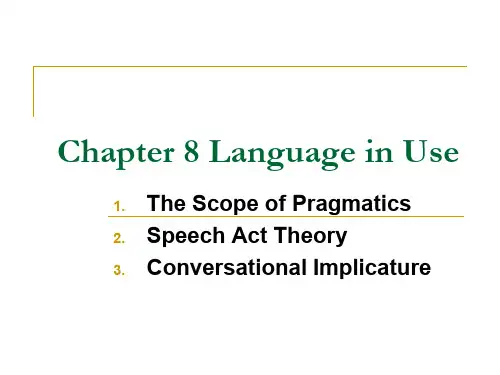
(c) The room was wanted for a meeting.
பைடு நூலகம்
(2) I can’t work under untidy circumstances.
are acts.
8.1.1 Performatives and constatives Austin (How to Do Things with Words,
1962) Consider these sentences: a) I name this ship Elizabeth. b) I bequeath my watch to my brother. c) I now pronounce you man and wife. d) I bet you sixpence it will rain
A. (i) There must be a relevant conventional procedure, and
(ii) the relevant participants and circumstances must be appropriate.
B. The procedure must be executed (i) correctly and (ii) completely.
Possible contexts:
(a) A request to someone to tidy up the circumstances.
(b) It was an excuse for not wanting to do something there.
胡壮林语言学重要章节笔记总结
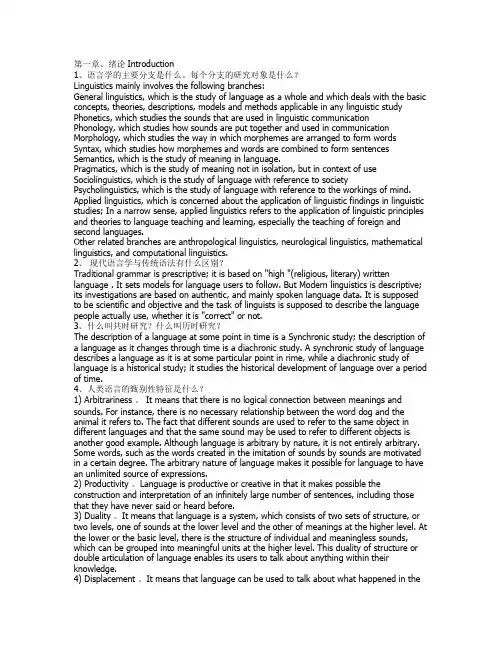
第一章、绪论Introduction1、语言学的主要分支是什么。
每个分支的研究对象是什么?Linguistics mainly involves the following branches:General linguistics, which is the study of language as a whole and which deals with the basic concepts, theories, descriptions, models and methods applicable in any linguistic study Phonetics, which studies the sounds that are used in linguistic communication Phonology, which studies how sounds are put together and used in communication Morphology, which studies the way in which morphemes are arranged to form words Syntax, which studies how morphemes and words are combined to form sentences Semantics, which is the study of meaning in language.Pragmatics, which is the study of meaning not in isolation, but in context of use Sociolinguistics, which is the study of language with reference to society Psycholinguistics, which is the study of language with reference to the workings of mind. Applied linguistics, which is concerned about the application of linguistic findings in linguistic studies; In a narrow sense, applied linguistics refers to the application of linguistic principles and theories to language teaching and learning, especially the teaching of foreign and second languages.Other related branches are anthropological linguistics, neurological linguistics, mathematical linguistics, and computational linguistics.2、现代语言学与传统语法有什么区别?Traditional grammar is prescriptive; it is based on "high "(religious, literary) written language . It sets models for language users to follow. But Modern linguistics is descriptive; its investigations are based on authentic, and mainly spoken language data. It is supposed to be scientific and objective and the task of linguists is supposed to describe the language people actually use, whether it is "correct" or not.3、什么叫共时研究?什么叫历时研究?The description of a language at some point in time is a Synchronic study; the description of a language as it changes through time is a diachronic study. A synchronic study of language describes a language as it is at some particular point in rime, while a diachronic study of language is a historical study; it studies the historical development of language over a period of time.4、人类语言的甄别性特征是什么?1) Arbitrariness 。
胡壮麟《语言学教程》(第5版)笔记和考研真题详解
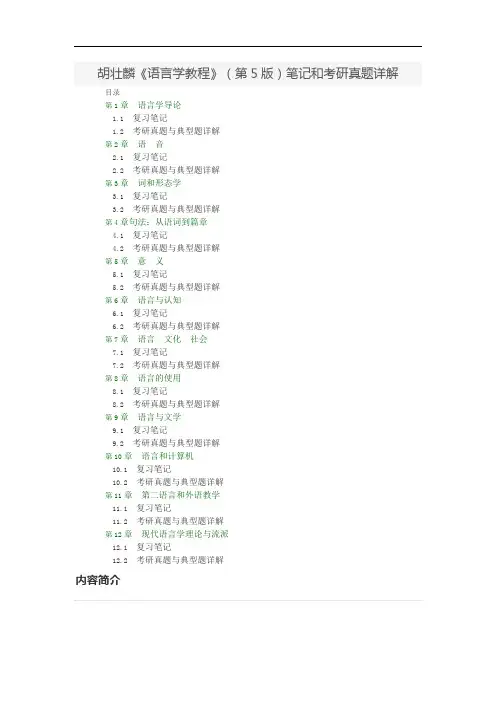
胡壮麟《语言学教程》(第5版)笔记和考研真题详解目录第1章语言学导论1.1复习笔记1.2考研真题与典型题详解第2章语音2.1复习笔记2.2考研真题与典型题详解第3章词和形态学3.1复习笔记3.2考研真题与典型题详解第4章句法:从语词到篇章4.1复习笔记4.2考研真题与典型题详解第5章意义5.1复习笔记5.2考研真题与典型题详解第6章语言与认知6.1复习笔记6.2考研真题与典型题详解第7章语言文化社会7.1复习笔记7.2考研真题与典型题详解第8章语言的使用8.1复习笔记8.2考研真题与典型题详解第9章语言与文学9.1复习笔记9.2考研真题与典型题详解第10章语言和计算机10.1复习笔记10.2考研真题与典型题详解第11章第二语言和外语教学11.1复习笔记11.2考研真题与典型题详解第12章现代语言学理论与流派12.1复习笔记12.2考研真题与典型题详解内容简介作为《语言学教程》(第5版)(胡壮麟主编,北京大学出版社)的学习辅导书,全书完全遵循该教材的章目编排,共分12章,每章由两部分组成:第一部分为复习笔记(中英文对照),总结本章的重点难点;第二部分是考研真题与典型题详解,精选名校经典考研真题及相关习题,并提供了详细的参考答案。
本书具有以下几个方面的特点:1.梳理章节脉络,浓缩内容精华。
每章的复习笔记以该教材为主并结合其他教材对本章的重难点知识进行了整理,并参考了国内名校名师讲授该教材的课堂笔记,因此,本书的内容几乎浓缩了经典教材的知识精华。
2.中英双语对照,凸显难点要点。
本书章节笔记采用了中英文对照的形式,强化对重要难点知识的理解和运用。
3.精选考研真题,补充难点习题。
本书精选名校考研真题及相关习题,并提供答案和详解。
所选真题和习题基本体现了各个章节的考点和难点,但又不完全局限于教材内容,是对教材内容极好的补充。
另外,在笔记部分,对于在《语言学教程》第三版或第四版提到而第五版删减的知识点我们也予以保留,并用“*”标明,部分院校考研真题依旧会涉及这些知识点的考查。
(完整版)胡壮麟语言学教程笔记、重点全解
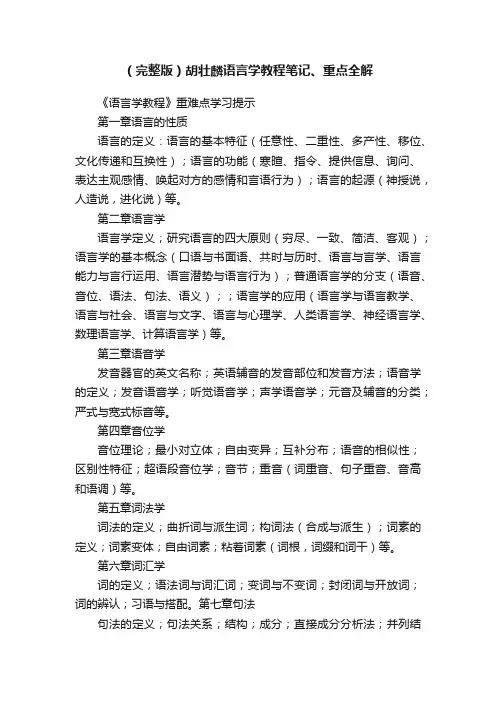
(完整版)胡壮麟语言学教程笔记、重点全解《语言学教程》重难点学习提示第一章语言的性质语言的定义:语言的基本特征(任意性、二重性、多产性、移位、文化传递和互换性);语言的功能(寒暄、指令、提供信息、询问、表达主观感情、唤起对方的感情和言语行为);语言的起源(神授说,人造说,进化说)等。
第二章语言学语言学定义;研究语言的四大原则(穷尽、一致、简洁、客观);语言学的基本概念(口语与书面语、共时与历时、语言与言学、语言能力与言行运用、语言潜势与语言行为);普通语言学的分支(语音、音位、语法、句法、语义);;语言学的应用(语言学与语言教学、语言与社会、语言与文字、语言与心理学、人类语言学、神经语言学、数理语言学、计算语言学)等。
第三章语音学发音器官的英文名称;英语辅音的发音部位和发音方法;语音学的定义;发音语音学;听觉语音学;声学语音学;元音及辅音的分类;严式与宽式标音等。
第四章音位学音位理论;最小对立体;自由变异;互补分布;语音的相似性;区别性特征;超语段音位学;音节;重音(词重音、句子重音、音高和语调)等。
第五章词法学词法的定义;曲折词与派生词;构词法(合成与派生);词素的定义;词素变体;自由词素;粘着词素(词根,词缀和词干)等。
第六章词汇学词的定义;语法词与词汇词;变词与不变词;封闭词与开放词;词的辨认;习语与搭配。
第七章句法句法的定义;句法关系;结构;成分;直接成分分析法;并列结构与从属结构;句子成分;范畴(性,数,格);一致;短语,从句,句子扩展等。
第八章语义学语义的定义;语义的有关理论;意义种类(传统、功能、语用);里奇的语义分类;词汇意义关系(同义、反义、下义);句子语义关系。
第九章语言变化语言的发展变化(词汇变化、语音书写文字、语法变化、语义变化);第十章语言、思维与文化语言与文化的定义;萨丕尔-沃夫假说;语言与思维的关系;语言与文化的关系;中西文化的异同。
第十一章语用学语用学的定义;语义学与语用学的区别;语境与意义;言语行为理论(言内行为、言外行为和言后行为);合作原则。
胡壮麟《语言学教程》笔记第8-9章
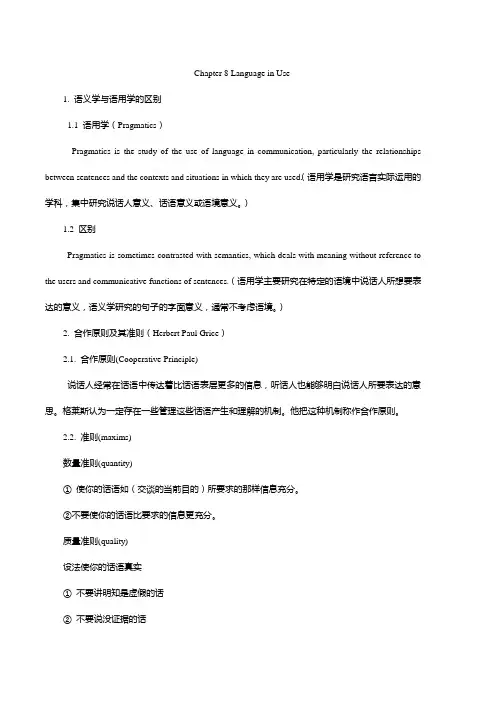
Chapter 8 Language in Use1. 语义学与语用学的区别1.1 语用学(Pragmatics)Pragmatics is the study of the use of language in communication, particularly the relationships between sentences and the contexts and situations in which they are used.(语用学是研究语言实际运用的学科,集中研究说话人意义、话语意义或语境意义。
)1.2 区别Pragmatics is sometimes contrasted with semantics, which deals with meaning without reference to the users and communicative functions of sentences.(语用学主要研究在特定的语境中说话人所想要表达的意义,语义学研究的句子的字面意义,通常不考虑语境。
)2. 合作原则及其准则(Herbert Paul Grice)2.1. 合作原则(Cooperative Principle)说话人经常在话语中传达着比话语表层更多的信息,听话人也能够明白说话人所要表达的意思。
格莱斯认为一定存在一些管理这些话语产生和理解的机制。
他把这种机制称作合作原则。
2.2. 准则(maxims)数量准则(quantity)①使你的话语如(交谈的当前目的)所要求的那样信息充分。
②不要使你的话语比要求的信息更充分。
质量准则(quality)设法使你的话语真实①不要讲明知是虚假的话②不要说没证据的话关系准则(relation)所谈内容要密切相关方式准则(manner)要清晰。
①避免含糊不清②避免歧义③要简练(避免冗长)④要有序3. 言语行为理论(Speech Act Theory)---John Austin3.1. 施为句&叙事句(Performatives & Constatives)施为句是用来做事的,既不陈述事实,也不描述情况,且不能验证真假;叙事句要么用于陈述,要么用于验证,可以验证真假。
《胡壮麟《语言学教程》(第5版)笔记和考研真题详解》读书笔记PPT模板思维导图下载精选全文完整版

9.2 考研真 题与典型题 详解
第10章 语言和计算机
10.1 复习 笔记
10.2 考研 真题与典型 题详解
第11章 第二语言和外语教学
11.1 复习 笔记
11.2 考研 真题与典型 题详解
第12章 现代语言学理论与流 派
12.1 复习 笔记
12.2 考研 真题与典型 题详解
读书笔记
谢谢观看
第1章 语言学导论
1.1 复习笔 记
1.2 考研真 题与典型题 详解
第2章 语 音
2.1 复习笔 记
2.2 考研真 题与典型题 详解
第3章 词和形态学
3.1 复习笔 记
3.2 考研真 题与典型题 详解
第4章 句法:从语词到篇章
4.1 复习笔 记
4.2 考研真 题与典型题 详解
第5章 意 义
5.1 复习笔 记
5.2 考研真 题与典型题 详解
第6章 语言与认知
6.1 复习笔 记
6.2 考研真 题与典型题 详解
第7章 语言 文化 社会
7.1 复习笔 记
7.2 考研真 题与典型题 详解
第8章 语言的使用
8.1 复习笔 记
8.2 考研真 题与典型题 详解
第9章 语言与文学
9.1 复习笔 记
08 第8章 语言的使用
09 第9章 语言与文学
010
第10章 语言和计算 机
011
第11章 第二语言和 外语教学
012
第12章 现代语言学 理论与流派
作为《语言学教程》(第5版)(胡壮麟主编,北京大学出版社)的学习辅导书,全书完全遵循该教材的章 目编排,共分12章,每章由两部分组成:第一部分为复习笔记(中英文对照),总结本章的重点难点;第二部分 是考研真题与典型题详解,精选名校经典考研真题及相关习题,并提供了详细的参考答案。本书具有以下几个方 面的特点:1.梳理章节脉络,浓缩内容精华。每章的复习笔记以该教材为主并结合其他教材对本章的重难点知识 进行了整理,并参考了国内名校名师讲授该教材的课堂笔记,因此,本书的内容几乎浓缩了经典教材的知识精华。 2.中英双语对照,凸显难点要点。本书章节笔记采用了中英文对照的形式,强化对重要难点知识的理解和运用。 3.精选考研真题,补充难点习题。本书精选名校考研真题及相关习题,并提供答案和详解。所选真题和习题基本 体现了各个章节的考点和难点,但又不完全局限于教材内容,是对教材内容极好的补充。另外,在笔记部分,对 于在《语言学教程》第三版或第四版提到而第五版删减的知识点我们也予以保留,并用“*”标明,部分院校考 研真题依旧会涉及这些知识点的考查。相对于第三版或第四版,对于在第五版新增加的知识点用“▼”标明,以 便于使用不同版本教材的读者使用。
语言学教程胡壮麟(第四版) 第8章
Chapter 8 Language in Use一、Some basic notions in pragmatics(1) Context:a basic concept in the study of pragmatics. It is generally considered as constituted knowledge shared by the speaker and the hearer, such as cultural background, situation, and the relationship between the speaker and the hearer, etc. The relevant constraints of the communicative situation that influence language use. For example, my bag is heavy.(2) Pragmatics vs. semanticsSemantics studies the literal meaning of a sentence. (without taking context into consideration) Pragmatics studies the intended meaning of a speaker. (taking context into consideration)(3) Sentence meaning and utterance meaning 句子意义和话语意义二、Speech act theoryThe first major theory in pragmatics, proposed by Austin. It is a theory which analyzes the role of utterances about the behavior of the speaker and the hearer in interpersonal communication. It aims to answer the question “What do we do when using language?” According to this theory, we are performing different kinds of acts when we are speaking.(1) Two types of utterances:① Performatives: sentences that don’t state a fact or describe a state and are not verifiable. It performs an act, including non-conventional acts such as promising, requesting and suggesting. E.g.:“I name this ship Elizabeth.”“I bet you six pounds it will rain tomorrow.”① Constatives: statements that either state or describe and are verifiable.Felicity conditions for performatives to be appropriate:A. (i) there must be a relevant conventional procedure,(①) the relevant participants and circumstances must be appropriate.B. The procedure must be executed(①) correctly and(①) completely.C. The relevant participants must(①) have the requisite thoughts, feelings and intentions, and(①) follow it up with actions as specified.(2) Austin’s new model of speech acts:Austin suggests that a speaker might be performing three acts simultaneously when speaking:①The first one is locutionary act: an act of saying something, that is, an act of making a meaningful utterance. It is an act of making the sentence and it is a description. For example, when someone says”It is cold here”, its locutionary act is the saying of it with its literal meaning the weather is cold here.①The second one is illocutionary act: an act performed in saying something, that is, in saying X, I was doing Y. And it indicates the speakers’ intention. For example, when we say”It is cold here”, its illocutionary act can be a request of the hearer to shut the window.①The third one is perlocutionary act: an act performed as a result of saying something, and the act is not related with the speaker’s intention. For example, “The weather is cold here.” Its perlocutionary act can be the hearer’s shutting the window or his refusal to comply with the request.Of the three acts, what speech act theory most concerned with is the illocutionary act. It trys to explain the ways by which speakers can mean more than what they say.Analyze the illocutionary acts of the following conversation between a couple:——— (the telephone rings)——— H: That’ the phone. (1)——— W: I’ m in the bathroom. (2)——— H: Okay. (3)This seemingly incoherent conversation goes on successfully because the speakers understand each other’s illocutionary acts:1) Asking his wife to go and answer the phone.2) A refusal to comply with the request; asking her husband to answer the phone instead.3) Accepting the wife’s refusal and accepting her request, meaning “all right, I’ll answer it.”(3) Searle’s classification of illocutionary acts:Searle has made great contribution to the development of the speech act theory. According to Searle, speech act are divided into five general categories. That is, five general types of things we do with language. Each type has a common, general purpose. They are representatives, directives, commsives, expressives, declarations. (阐述类、指令类、承诺类、表达类、宣告类)三、The theory of conversational implicature 会话含义理论The second major theory in pragmatics. Proposed by Grice.In daily communication, people are observing a set of basic rules of cooperating with each other so as to communicate effectively through conversation. He calls this set of rules the cooperative principle elaborated in four maxims.(1) Cooperative principle (CP)In making a conversation, all participants are expected to observe a general principle: Make your conversational contribution such as is required, at the stage at which it occurs, by the accepted purpose or direction of the talk exchange in which you are engaged.Four maxims of CP:1) The maxim of quantity1) Make your contribution as informative as is required (for the current purposes of the exchange).2) Do not make your contribution more informative than is required.2) The maxim of qualityTry to make your contribution one that is true.1) Do not say what you believe to be false.2) Do not say that for which you lack adequate evidence.3) The maxim of relationBe relevant.4) The maxim of mannerBe perspicuous.1) Avoid obscurity of expression.2) Avoid ambiguity.3) Be brief.4) Be orderly.(2) Conversational implicatureAccording to Grice, it refers to the extra meaning not contained in the utterance, but understandable to the listener. Only when he shares the speakers’ knowledge or he knows why and how, he violates intentionally one of the four maxims of CP.The following provides different circumstances of the violation of CP and its maxims.1) Violation of the maxim of quantityA:When is Lucy’s birthday party?B:Sometimes next month.A:Where is X?B:He’s gone to the library. He said so when he left.2) Violation of the Maxim of qualityHe is made of iron. (Metaphor)Every nice girl loves a sailor.3) Violation of the maxim of relationA: How do you like my painting?B: I’m afraid I don’t have any eye for beauty. A: What time is it?B: The postman has just arrived.4) Violation of the maxim of mannerA: Shall we get something for the kids?B: Yes. But I veto I-C-E-C-R-E-A-M.A:Where is your mother?B: She is either in the room or at the market. (3) Characteristics of implicature(4) Politeness Principle (PP)Leech suggests that CP can’t explain why people are often so indirect in conveying what they mean. Conversational interaction is a social behaviour. Choice of linguistic codes is central in language use. There are social and psychological factors that determined the choice.Besides being cooperative, participants try to be polite. And the speakers consider the matter of face for themself and others. Based on this observation, Leech proposed PP, which contains six maxims.1.Tact 策略Minimize cost to other.Maximize benefit to other.2.Generosity 宽宏Minimize benefit to self.Maximize cost to self.3.Approbation 赞扬Minimize dispraise of other.Maximize praise of other.4.Modesty 谦虚Minimize praise of self.Maximize dispraise of self.5.Agreement 赞同Minimize disagreement between self and other.Maximize agreement between self and other.6.Sympathy 同情Minimize antipathy between self and other.Maximize sympathy between self and other.四、Post-Gricean Developments3.Levinson’s Q- , I- and M- principles。
胡壮麟语言学教程笔记、重点
1. 语言的普遍特征:任意性arbitrariness双层结构duality 既由声音和意义结构多产性productivity移位性displacement:我们能用语言可以表达许多不在场的东西文化传播性cultural transmission2。
语言的功能:传达信息功能informative人济功能:interpersonal行事功能:Performative表情功能:Emotive寒暄功能:Phatic娱乐功能recreatinal元语言功能 metalingual3. 语言学linguistics:包括六个分支语音学Phonetics音位学 phonology形态学 Morphology句法学 syntax语义学 semantics语用学 pragmatics4. 现代结构主义语言学创始人:Ferdinand de saussure提出语言学中最重要的概念对之一:语言与言语language and parole ,语言之语言系统的整体,言语则只待某个个体在实际语言使用环境中说出的具体话语5. 语法创始人:Noam Chomsky提出概念语言能力与语言运用competence and performance1. Which of the following statements can be used to describe displacement. one of the unique properties of language:a. we can easily teach our children to learn a certain languageb. we can use both 'shu' and 'tree' to describe the same thing.c. we can u se language to refer to something not presentd. we can produce sentences that have never been heard before.is the most important function of language?a. interpersonalb. phaticc. informativefunction of the sentence "A nice day, isn't it ?"is __a informativeb. phaticc. directived. performativedistinction between competence and performance is proposed by __a saussureb. hallidayc. chomskyd. the prague school5. Who put forward the distinction between language and parole?a. saussureb. chomskyc. hallidayd anomymous第二节语音学1.发音器官由声带the vocal cords和三个回声腔组成2.辅音consonant:there is an obstruction of the air stream at some point of the vocal tract.3.辅音的发音方式爆破音 complete obstruction鼻音 nasals破裂音 plosives部分阻塞辅音 partial obstruction擦音 fricatives破擦音 affricates等4.辅音清浊特征voicing辅音的送气特征 aspiration5.元音vowel分类标准舌翘位置,舌高和嘴唇的形状6双元音 diphthongs,有元音过渡 vowel glides1. Articulatory phonetics mainly studies __.a. the physical properties of the sounds produced in speechb. the perception of soundsc. the combination of soundsd. the production of sounds2. The distinction between vowel s and consonants lies in __a. the place of articulationobstruction f airstreamc. the position of the tongued. the shape of the lips3. What is the common factor of the three sounds: p, k ta. voicelessb. spread4. What phonetic feature distinguish the p in please and the p in speak?a. voicingb. aspirationd. nasalityof the following is not a distinctive feature in English?a. voicingc. approximationd. aspirationphonological features of the consonant k are __a. voiced stopb. voiceless stopc. voiced fricatived. voiceless fricativeis divverent from k in __a. the manner of articulationb. the shape of the lipsc. the vibration of the vocal cordspalce of articualtionof the vocal cords results in __a. aspirationc. obstructiond. voicing第三节音位学 phonology1.音位学与语音学的区别:语音学着重于语音的自然属性,主要关注所有语言中人可能发出的所有声音;音位学则强调语音的社会功能,其对象是某一种语言中可以用来组合成词句的那些语音。
胡壮麟《语言学教程》第九章Language_and_Literature
Thus the term covers a wide area of meaning. This may have its advantages, but may also be problematic: which of the above meanings is intended must often be deduced from the context in which the term is used.
2.1 What is ‘foregrounding’? foregrounding’
In a purely linguistic sense, the term ‘foregrounding’ is used to foregrounding’ refer to new information, in contrast to elements in the sentence which form the background against which the new elements are to be understood by the listener / reader.
12
The red-haired woman, redsmiling, waving to the disappearing shore. She left the maharajah; she left maharajah; innumerable other lights o’ o’ passing love in towns and cities and theatres and railway stations all over the world. But Melchior she did not leave.
胡壮麟《语言学教程》笔记和考研真题及典型题详解(语言的使用)【圣才出品】
第8章语言的使用8.1 复习笔记本章要点:1. Speech act theory言语行为理论2. Cooperative principle and its maxims合作原则及其准则3. Gricean theory of conversational implicature格莱斯会话含义理论4. Politeness principle礼貌原则5. Post-Gricean developments后格莱斯时期的发展常考考点:语用学的定义;语义学与语用学的区别;语境与意义;言语行为理论(发话行为、行事行为和取效行为);合作原则。
实例分析言语行为、合作原则的违反和会话含义。
“话语意义”和“句子意义”的区别。
本章内容索引:I. Pragmatics1. Definition2. Difference between pragmatics and semantics II. Speech Act Theory1. Performatives and Constatives(1) Definition(2) Felicity Conditions2. A Theory of the Illocutionary Act3. Searle’s Classification of Speech Acts(1) Representatives:(2) Directives(3) Commsives(4) Expressives(5) DeclarationsIII. Cooperative Principle (CP)1. Cooperative Principle and Its Maxims2. Violation of the MaximsIV. Conversational Implicature1. Definition2. Characteristics of Conversational Implicature(1) Calculability.(2) Cancellability(3) Non-detachability(4) Non-conventionality.V. Politeness Principle (PP)VI. Post-Gricean Developments1. Relevance Theory2. The Q- and R-principles3. Levinson’s Q-, I-and M-principles▼4. A socio-cognitive approachI. Pragmatics (语用学)【考点:Pragmatics与Semantics的异同】1. Definition (定义)Pragmatics is the study of language in use, focusing on the study of speaker’s meaning, utterance meaning or contextual meaning.语用学是研究语言实际运用的学科,集中研究说话人意义、话语意义或语境意义。
- 1、下载文档前请自行甄别文档内容的完整性,平台不提供额外的编辑、内容补充、找答案等附加服务。
- 2、"仅部分预览"的文档,不可在线预览部分如存在完整性等问题,可反馈申请退款(可完整预览的文档不适用该条件!)。
- 3、如文档侵犯您的权益,请联系客服反馈,我们会尽快为您处理(人工客服工作时间:9:00-18:30)。
Chapter 8 Language in Use1. 语义学与语用学的区别1.1 语用学(Pragmatics)Pragmatics is the study of the use of language in communication, particularly the relationships between sentences and the contexts and situations in which they are used.(语用学是研究语言实际运用的学科,集中研究说话人意义、话语意义或语境意义。
)1.2 区别Pragmatics is sometimes contrasted with semantics, which deals with meaning without reference to the users and communicative functions of sentences.(语用学主要研究在特定的语境中说话人所想要表达的意义,语义学研究的句子的字面意义,通常不考虑语境。
)2. 合作原则及其准则(Herbert Paul Grice)2.1. 合作原则(Cooperative Principle)说话人经常在话语中传达着比话语表层更多的信息,听话人也能够明白说话人所要表达的意思。
格莱斯认为一定存在一些管理这些话语产生和理解的机制。
他把这种机制称作合作原则。
2.2. 准则(maxims)数量准则(quantity)①使你的话语如(交谈的当前目的)所要求的那样信息充分。
②不要使你的话语比要求的信息更充分。
质量准则(quality)设法使你的话语真实①不要讲明知是虚假的话②不要说没证据的话关系准则(relation)所谈内容要密切相关方式准则(manner)要清晰。
①避免含糊不清②避免歧义③要简练(避免冗长)④要有序3. 言语行为理论(Speech Act Theory)---John Austin3.1. 施为句&叙事句(Performatives & Constatives)施为句是用来做事的,既不陈述事实,也不描述情况,且不能验证真假;叙事句要么用于陈述,要么用于验证,可以验证真假。
3.2. 行事行为理论(A theory of the illocutionary act)发话行为: 是说出词、短语、分句的行为,是通过句法、词汇和音位手段表达字面意义的行为。
行事行为:表达说话人意图的行为,是在说话过程中所完成的行为。
取效行为:是通过说话完成或通过说话所产生的行为,是由话语所带来的结果和变化。
4.会话含义和合作原则的违反4.1. 格赖斯会话含义理论根据格莱斯的理论,会话含义指不包含在话语之内的额外意义。
这种额外意义只有当听话者和说话者具有共同知识,或听话者知道说话者为什么和如何有意违背会话合作原则中的某一原则是,才是可以理解的。
4.2. 会话含义的特征可推导性(calculability)可取消性(cancellability)不可分离性(non-detachability)非传统性(non-conventionality)4.3. 合作原则的违反使用原则和准则这两个术语,并不是说每个人一直遵守合作原则及其四条准则。
人们会违反准则,会撒谎。
也因为如此而产生了会话意义。
①Quantity-When is Susan’s birthday party?-Sometime next week.-We’ll all miss Bill and Jane, won’t we?-Well, we’ll all miss Bill.[We didn’t miss Jane.]②Quality---tell lies; rhetoric deviceHe is made of iron.She is the cream in my coffee.③Relation-How do you like my painting?-I’m afraid I don’t have an eye for beauty,[I don’t like it at all.]-What do you think of the party?-I thought the party we had was too big.[The party was dull or boring.]④Manner-Where is your mother?-She is either in her room or at the market.[I don’t know exactly where she is.]5. 后格莱斯时期的发展5.1. 关联原则---Dan Sperber & Deirdre WilsonDan Sperber & Deirdre Wilson二人认为,格莱斯准则,包括合作原则本身,都可以简化成为一条关联原则。
其定义:每一个明示交际活动,都传递一种假定:该行动本身具备最佳关联性。
5.2. Q-原则&R-原则---Laurence Horn①Q-原则(基于听话人)你的话语要充分(参照数量准则第一条此则)说的尽可能多(在符合R-原则的前提下)②R-原则(基于说话人)你的话语应是必须的(参照关系准则、数量准则第二条此则和方式准则)只说必须的(在符合Q-原则的前提下)5.3. Q-原则, I-原则, & M-原则---Stephen LevinsonShort Answer Questions1. What are the four maxims of the co-operative principle? Which maxim does this speaker seem to be particularly careful about:“well, to be quite honest, I don’t think she is ill today.”p1292. What is conversational implicature? p130Chapter 9 Language and Literature1. Stylistics(文体学)1.1文体学文体学作为语言学的分支,主要研究特殊语境中语言的特征(即语言的多样性),并试图建立一些规则,以解释个体和社团在语言使用过程中的特殊选择。
1.2. Literary Stylistics(文学文体学)文学文体学是研究语言与文学关系的学科,其研究焦点是与文学文体相关的语言特征。
1.3. Foregrounding(前景化)前景化被定义为“以艺术手法为动机的偏离”。
这种偏离,或非常规用法,覆盖了语言的所有层面:词汇、语音、句法、语义、笔迹等。
2. Literal Language & Figurative Language(原语言&比喻语言)2.1. 原语言词典定义中所提供的一个词的第一个意义通常是它的字面意义。
2.2. 比喻语言比喻语言是为了达到对比、强调、明确或标新的目的而使用的不同于日常常规语言的词句。
①明喻②暗喻③转喻:一种一个词或词组被另一个与之有密切联系的词或词组替换的修辞方法。
④提喻:用事物的一部分名称指代整个事物,反之亦然。
3. 诗歌中的语言3.1. 不同的语音模式尾韵:每行结尾的押韵头韵:在头韵里,句首的辅音是一致的。
准押韵:准押韵通过一个共同的元音来描述音节。
辅音韵:以相同辅音结尾的音节。
反韵:指音节拥有共同的元音和首辅音3.2. 不同的韵律模式对句: 两行诗句,一般由押韵联系在一起。
四行诗:四行为一节的诗,是英语诗歌中很常见的形式。
无韵诗:由不押韵的抑扬格五音步诗组成的。
十四行诗、自由体诗、打油诗等4. 小说中的语言4.1. First-person narrator (I-narrator)(第一人称叙述者)The person who tells the story may also be a character in the fictional world of the story, relating the story after the event. In this case, the critics call the narrator a first-person narrator or an I-narrator because when the narrator refers to himself or herself in the story the first person pronoun “I”is used.讲故事的人也可能成为故事虚构世界中的一个角色,在时间发生后讲述故事。
在这种情形下,评论家们称叙述者为“第一人称叙述者”或“I叙述者”,因为叙述者在故事里提到他或她自己时走势用第一人称代词“我”。
4.2. Third-person narrator(第三人称叙述者)If the narrator is not a character in the fictional world, he or she is usually called a third-person narrator, because reference to all the characters in the fictional world of the story will involve the use of the third-person pronouns, he, she, it or they.(如果叙述者不是虚拟世界中的角色,他或她常常被称为“第三人称叙述者”,因为故事虚构世界中的所有人被提及时,用的都是第三人称代词“它、他、她或他们”。
)4.3. 言语表达①直接引语:在直接引语中,人物所说的话是以最全面的形式出现的并且带有引号。
②间接引语:我们能够知道说话者表达的命题含意,但并不是说话者的原话。
③叙事者对言语行为的表达:我们不知道说话者说话的内容,我们只知道他用言语行为来做事。
这种叙述可以被看做是对较长语篇的概括,比起间接言语,它提供了更多的背景信息。
④叙事者对言语的表达:仅仅是一个告诉我们某人说话了的句子,甚至连具体是什么言语行为都没说。
4.4. 思维表达①直接思维:②自由间接思维4.5. Stream of consciousness writing(意识流写作)It is used to describe the free association of ideas and impressions in the mind. It is characterized by a highly elliptical sentence structure. (意识流写作被用来描述思维中印象和观念的自由联系。
